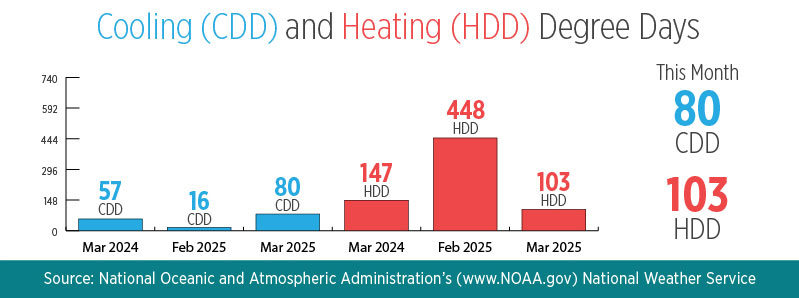
March 2025 wasn’t unusually hot or cold – the average temperature was 64 degrees, which is just about perfect for Texas weather. CoServ Members should expect their energy usage to be lower than February.
Last month will be best remembered for high winds, with average speeds of about 13 mph. In Fort Worth, wind gusts topped 70 mph on March 4 – near hurricane-force winds!
Temperatures dipped as low as 37 degrees on March 10. In all, there were seven days with temperatures at 45 degrees or lower. Contrast that with March 25 when temperatures reached 90 degrees. There were 16 days overall where temperatures topped 80 degrees.
| February | March | Difference | |
| Average temperature | 49.3 | 64 | 14.7 degrees warmer |
| Heating Degree Days | 448 | 103 | 345 less HDD |
| Cooling Degree Days | 16 | 80 | 64 more CDD |
| Utilities and the federal government measure the impact of weather on energy usage by calculating Cooling Degree Days (CDD) and Heating Degree Days (HDD). To calculate the CDD, take the average temperature for a day and subtract it from 65. The higher the number, the more air conditioning will be needed to keep your home comfortable. Click here for more information on calculating CDD. | |||
As the graphic above shows, North Texans likely used just as much heating as they did air conditioning, depending on the day.
CoServ Gas Customers should notice less gas usage than in February because they didn’t need their heaters as much. The HDD dropped by 77%.
This March was fairly similar to March 2024, with the average temperature about 2.2 degrees warmer. Overall, the HDD were 30% lower for March 2025 compared to the same period last year.
Rates
The other important factor in your CoServ electric bill is the cost per kilowatt-hour.
For the 10th month in a row, CoServ maintained the Power Cost Recovery Factor (PCRF) as a negative number, meaning it subtracted from the base rate. The PCRF will be -$0.005 for April billing.
We make every effort to keep electricity rates affordable while delivering safe and reliable power to Members. When we save money by making strategic wholesale purchases, we pass that on to Members.
Click here to learn more about how your CoServ rate is calculated.




